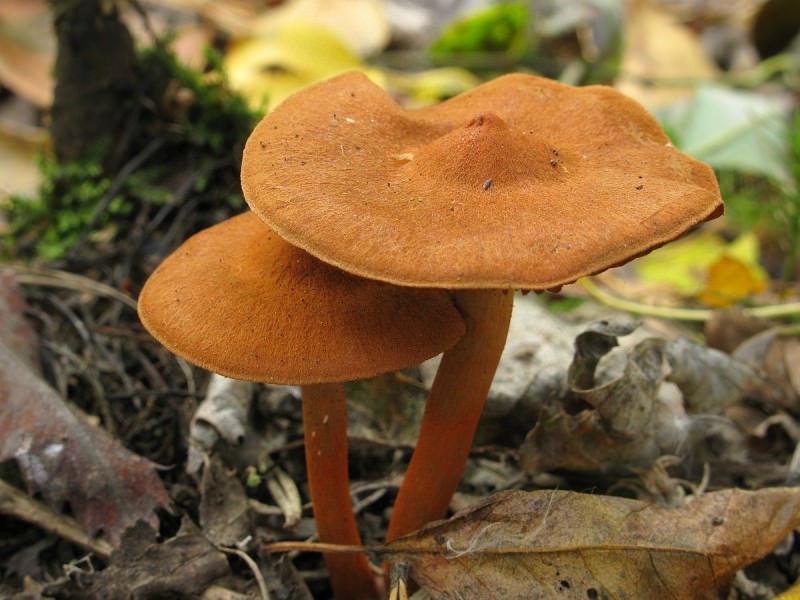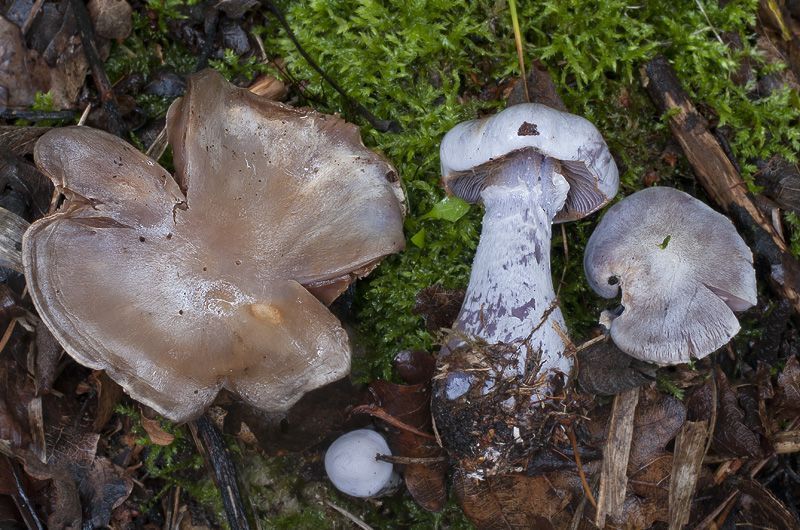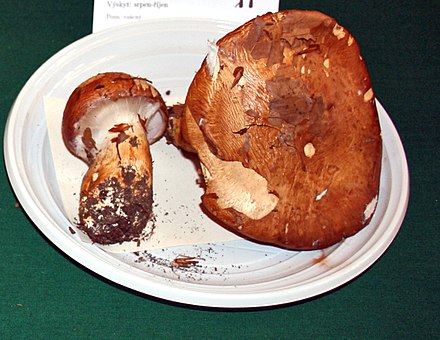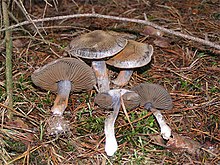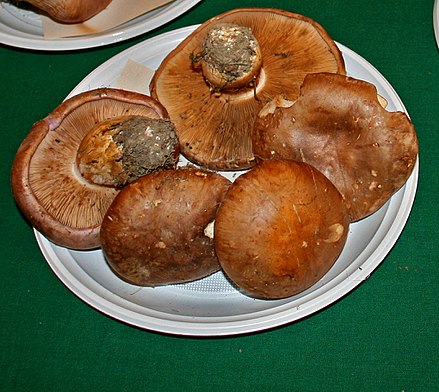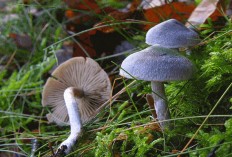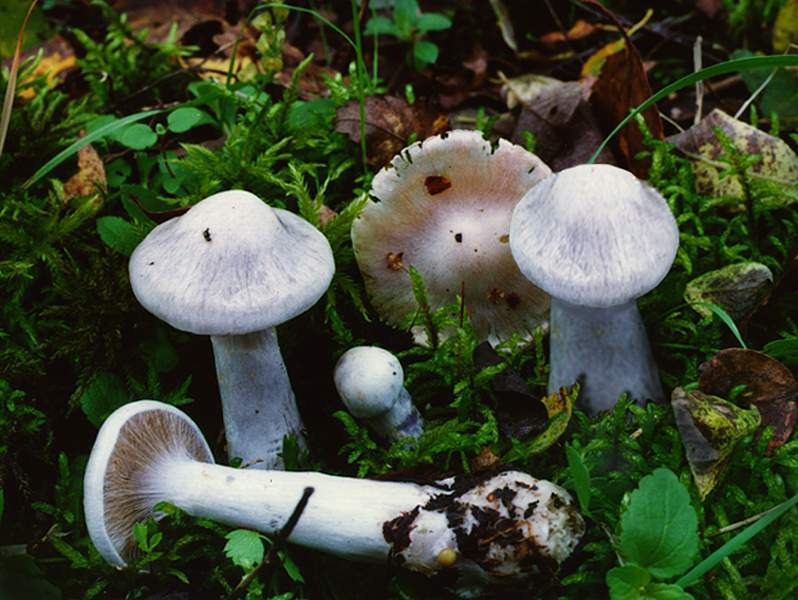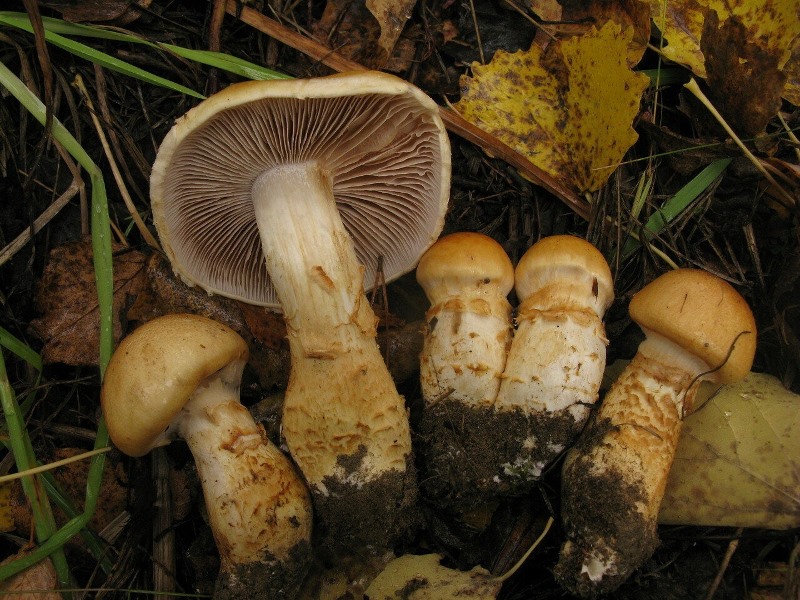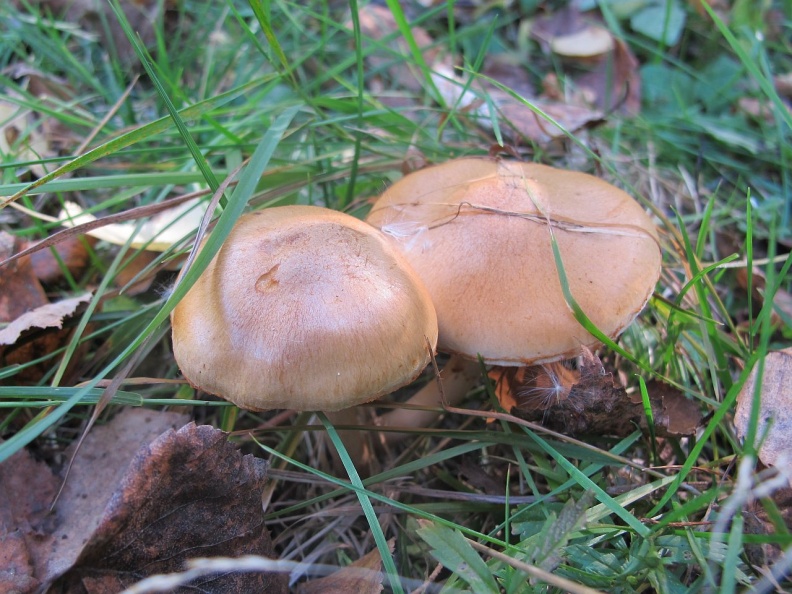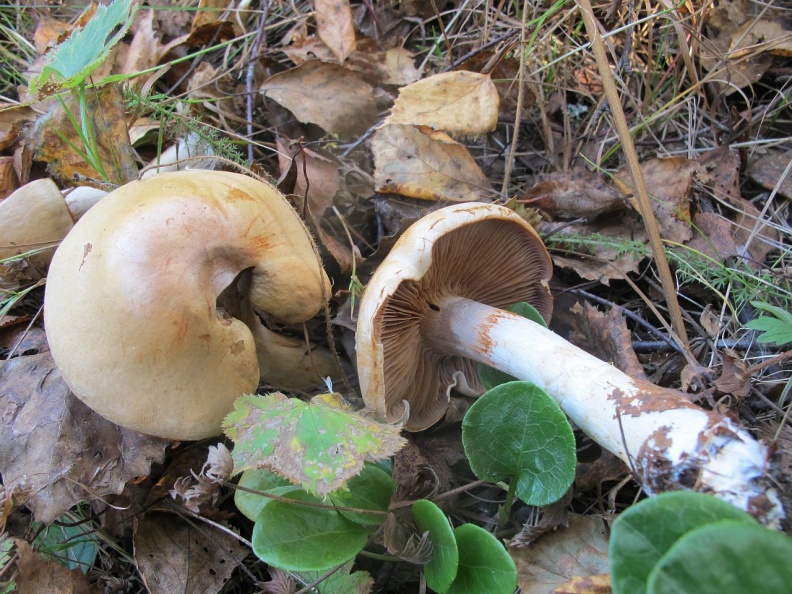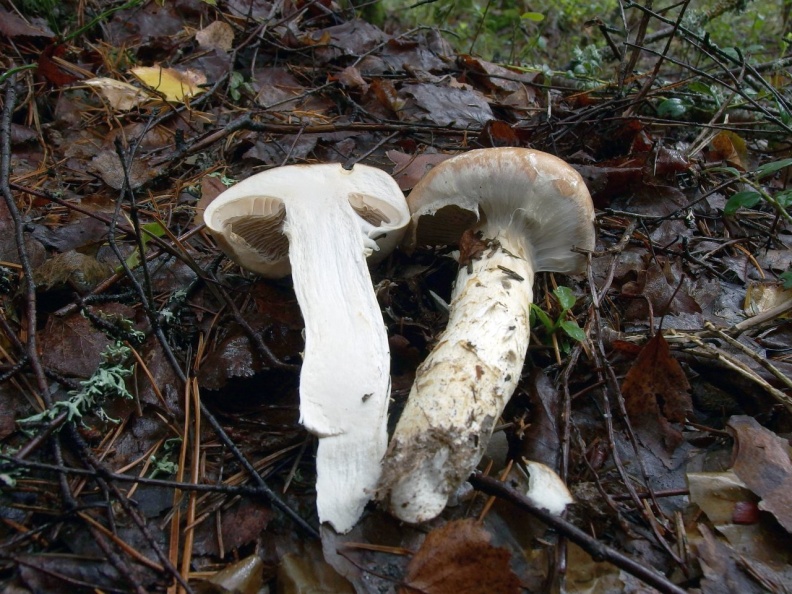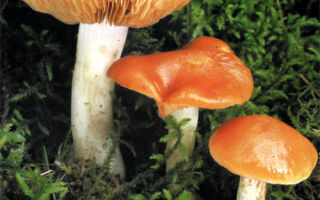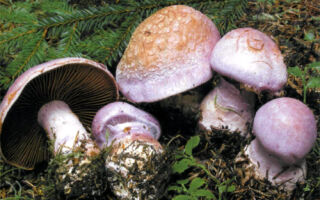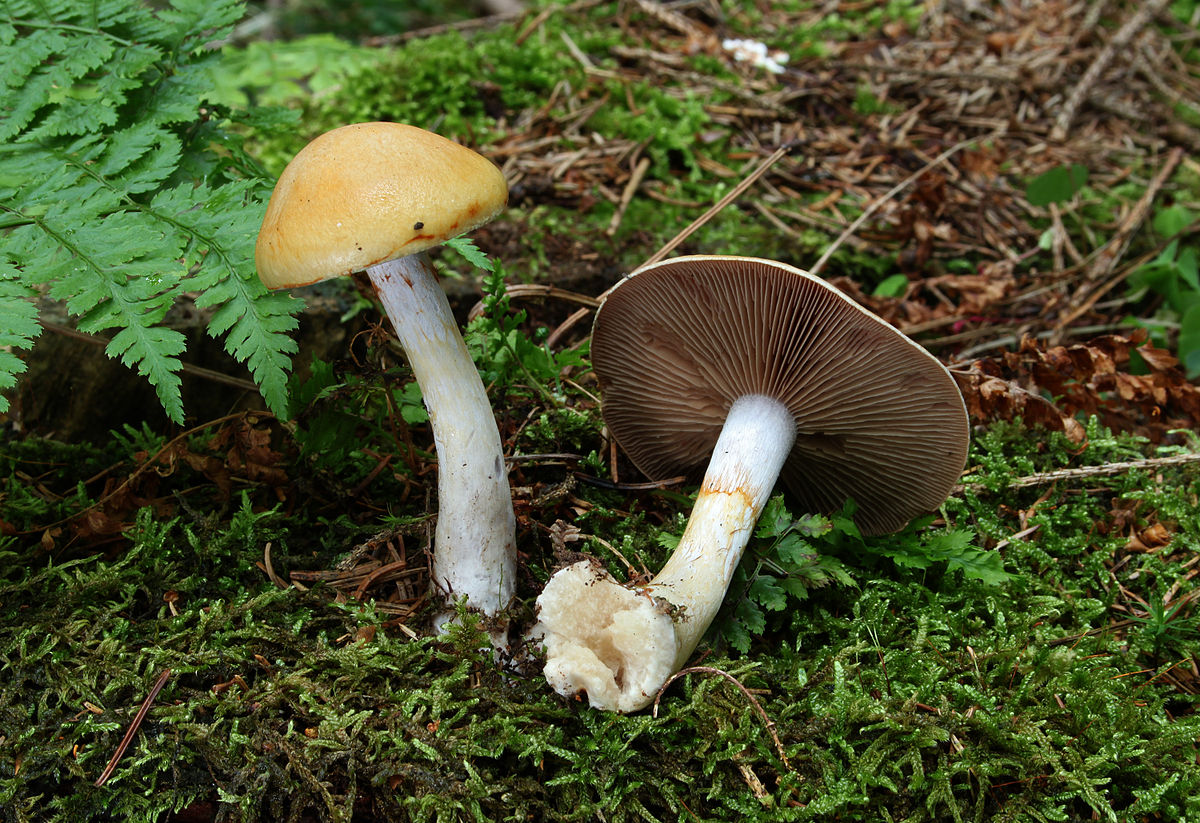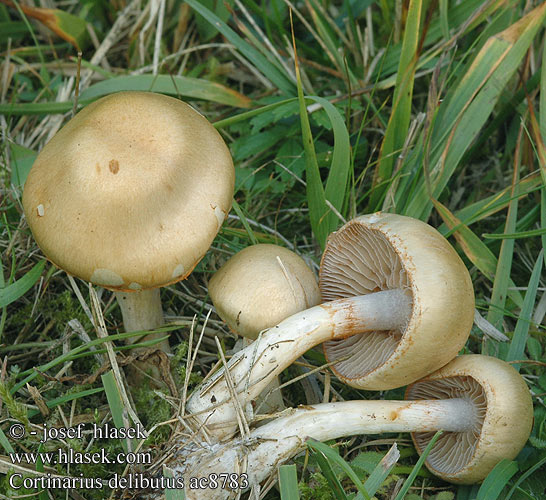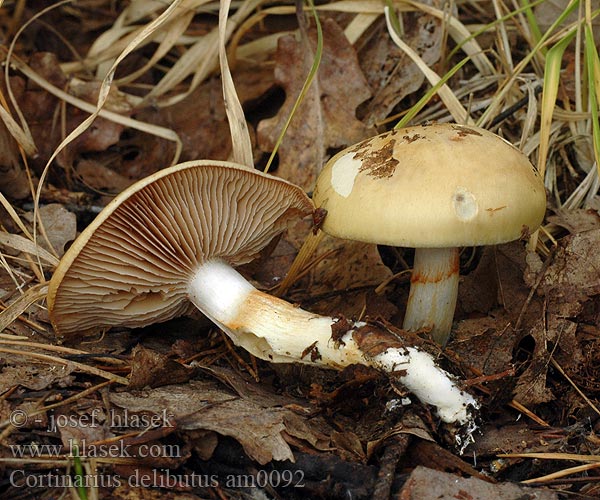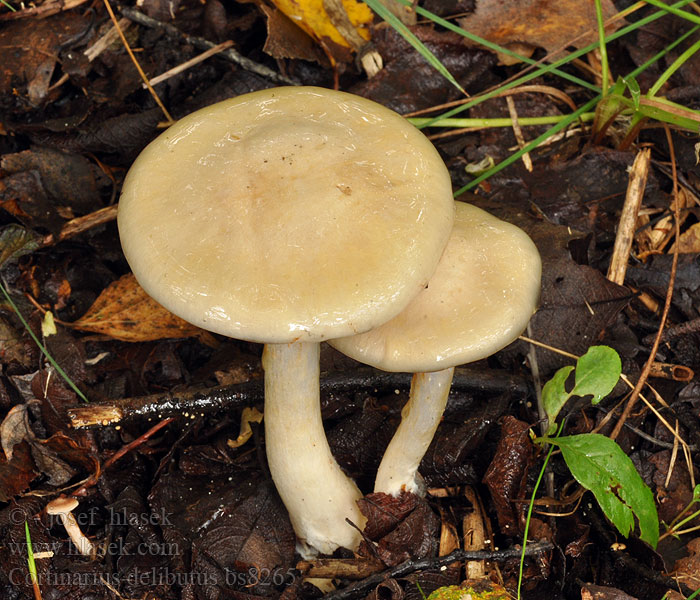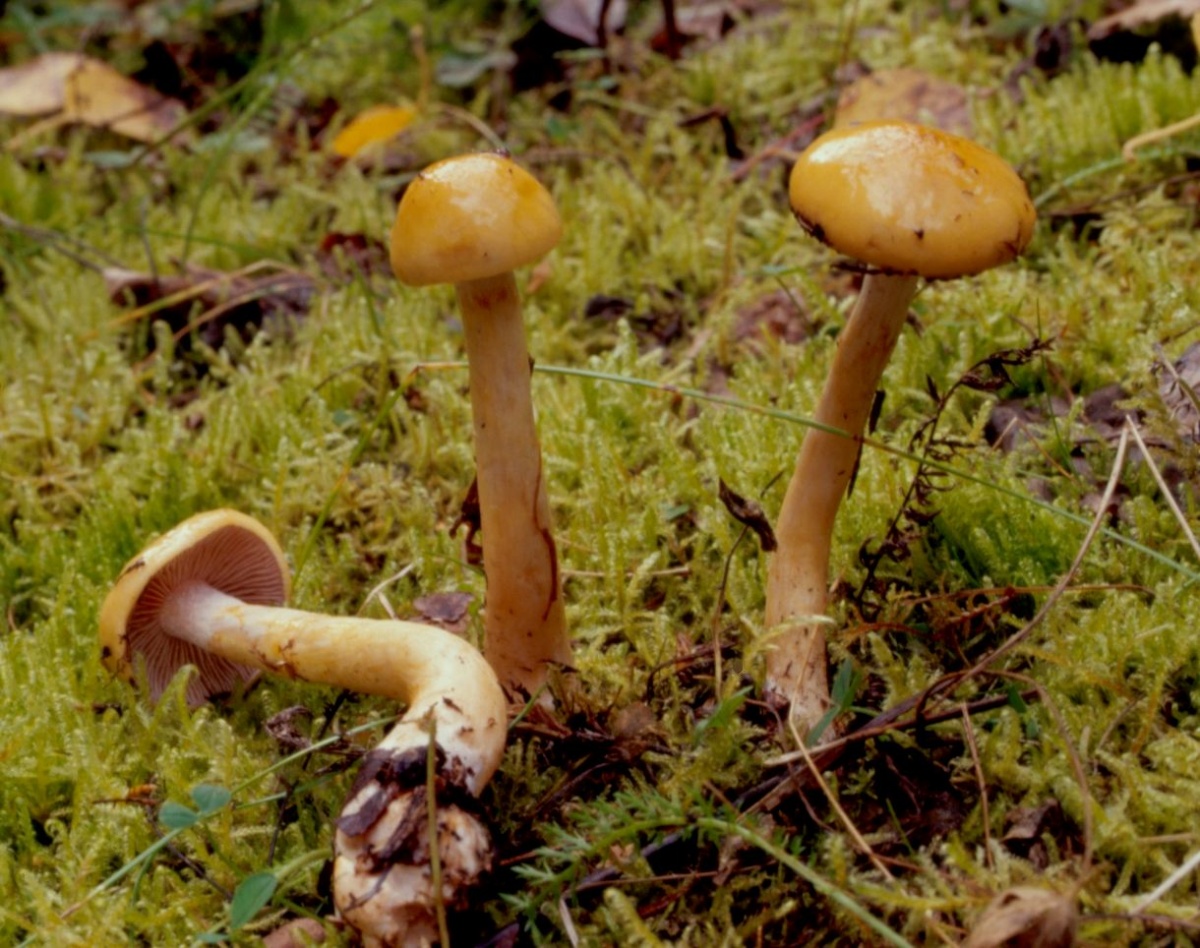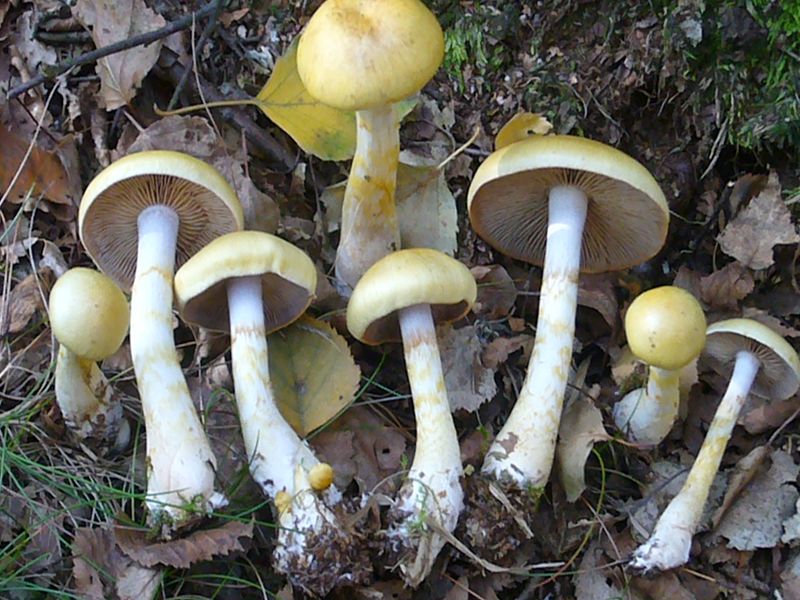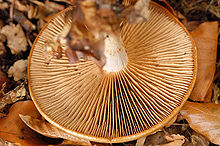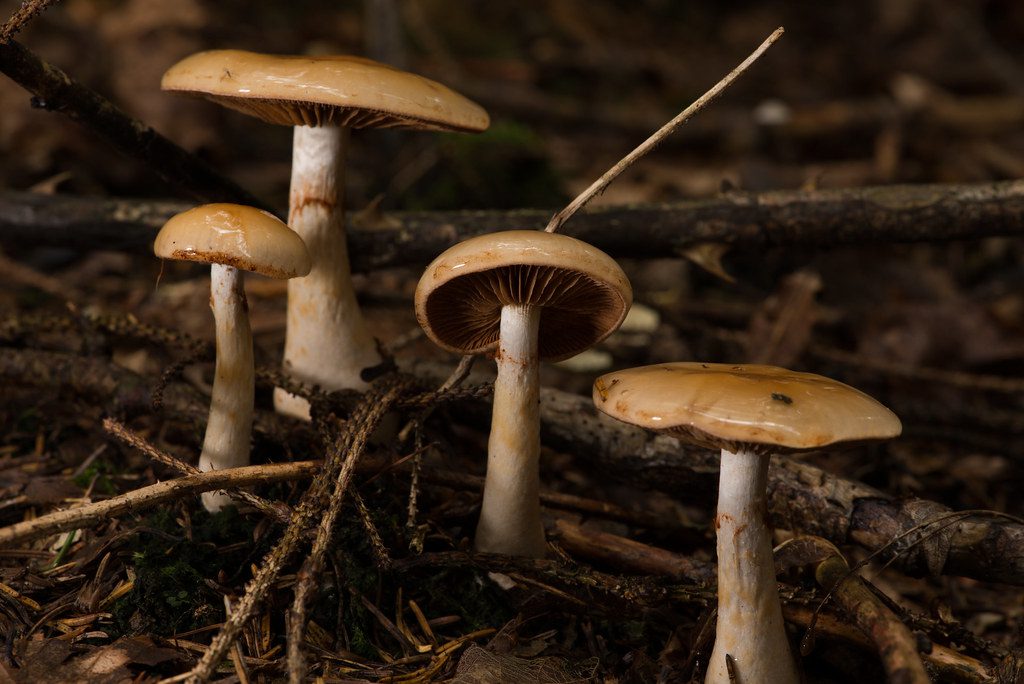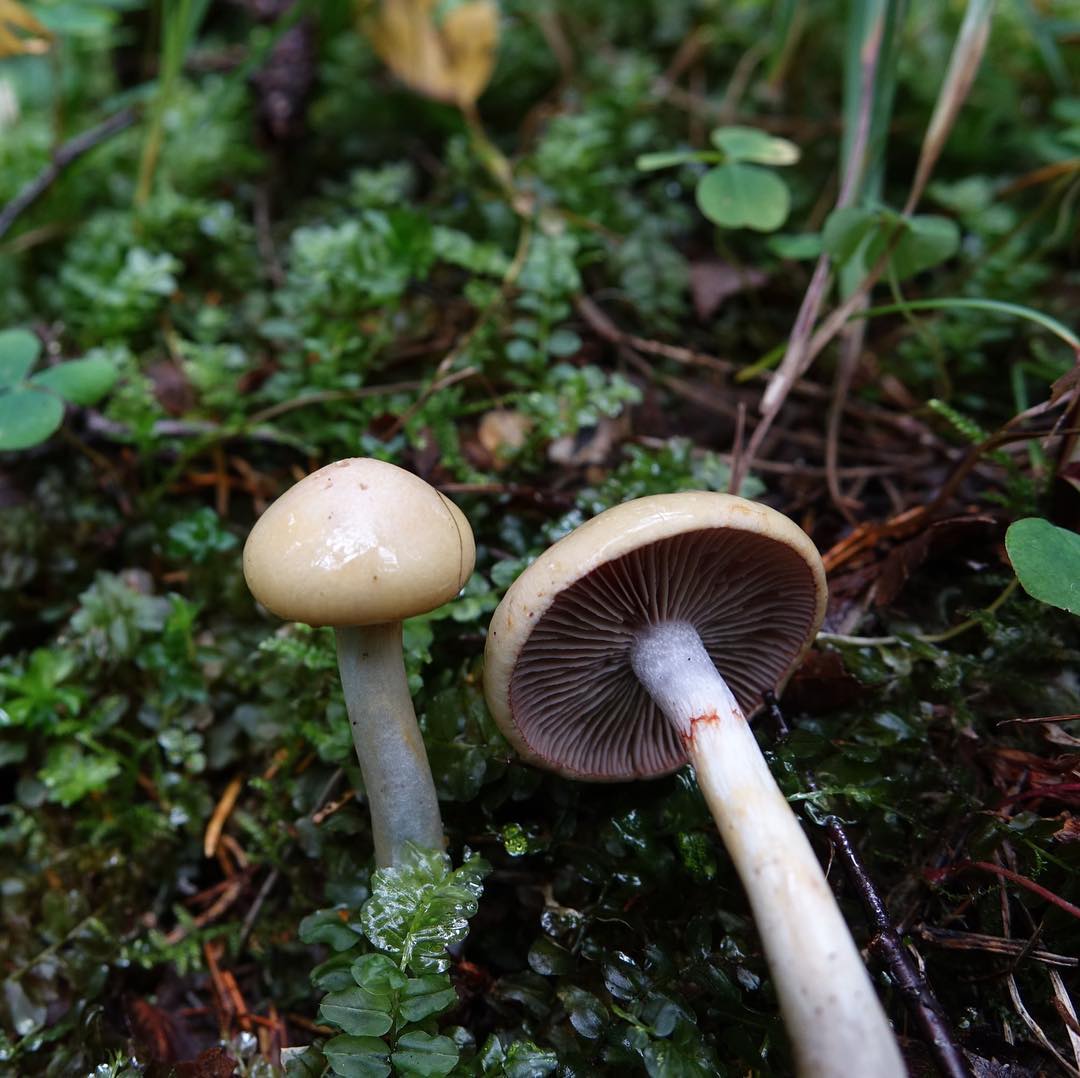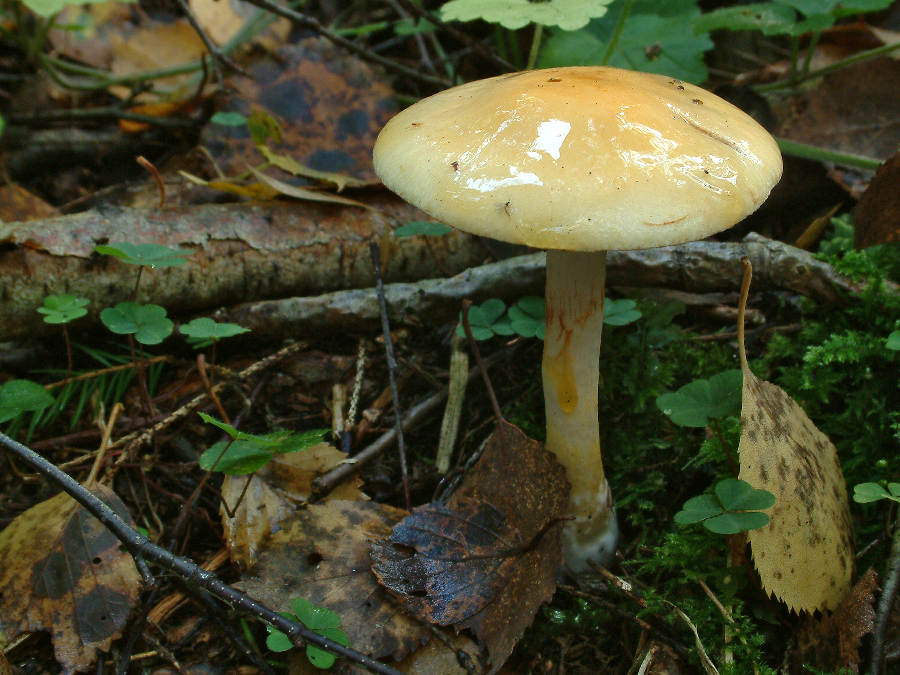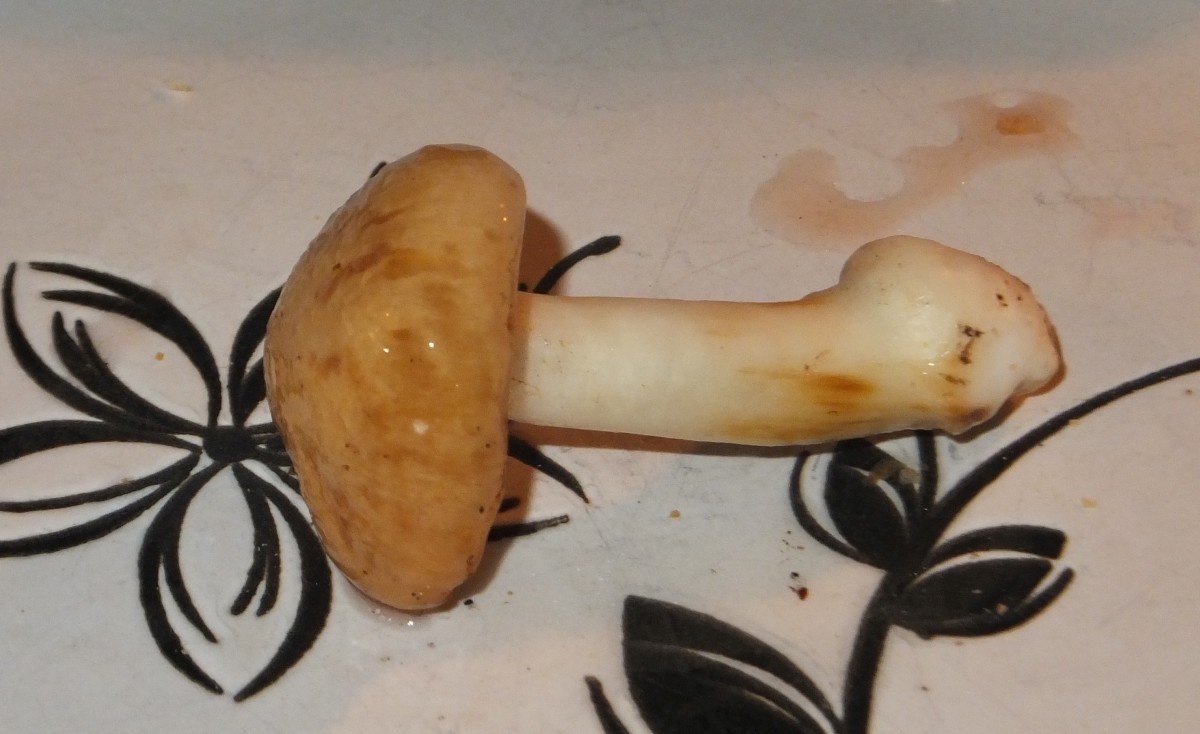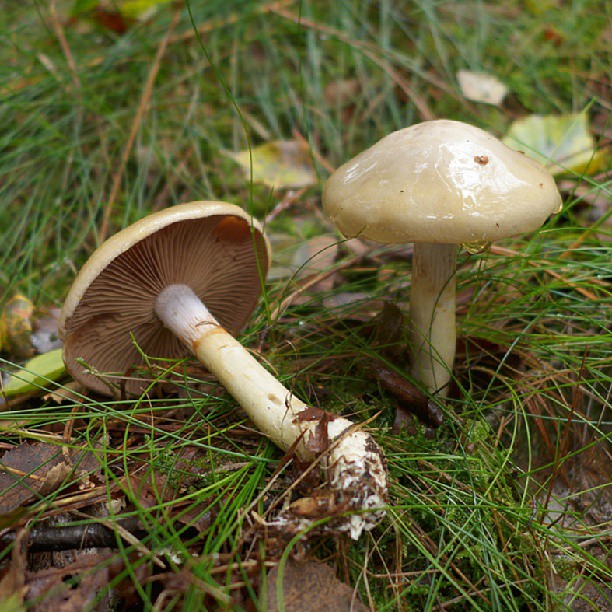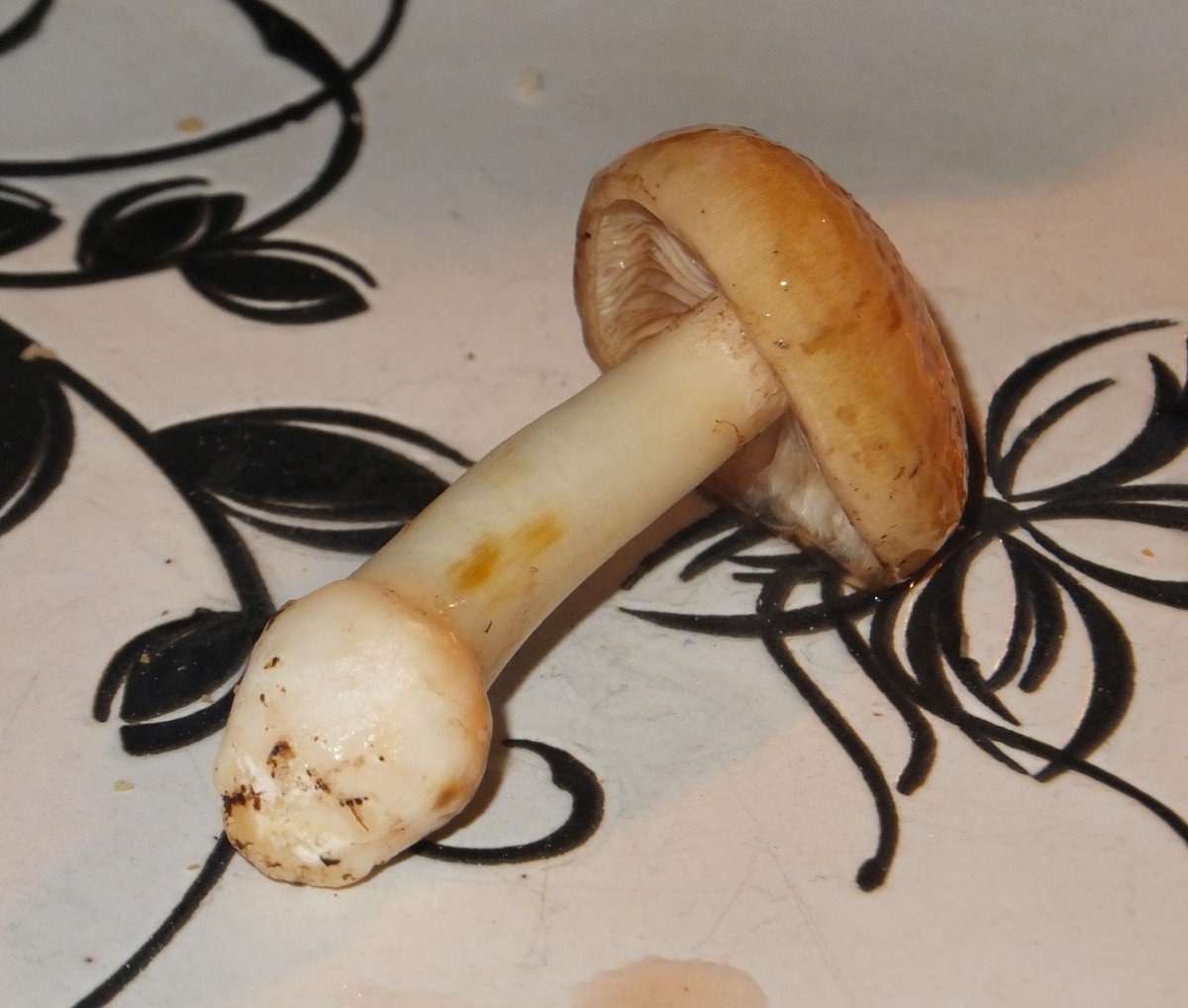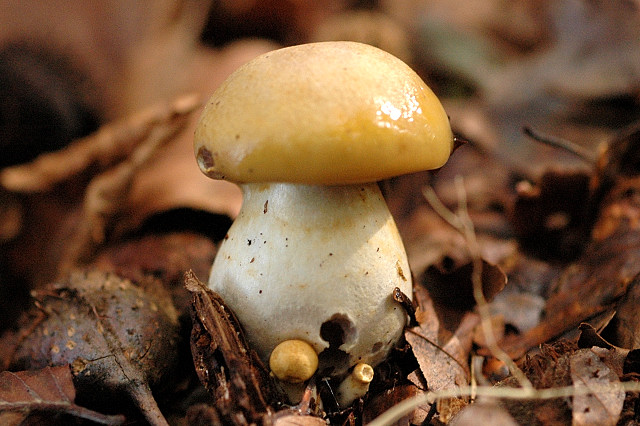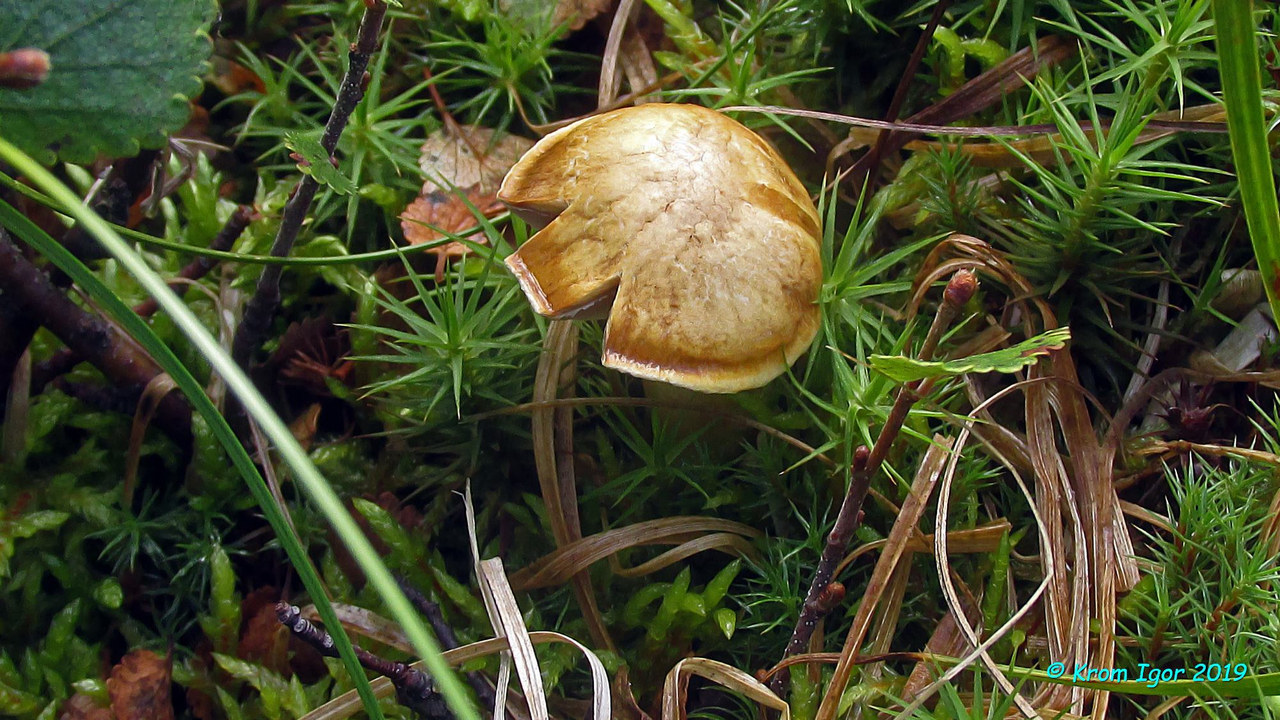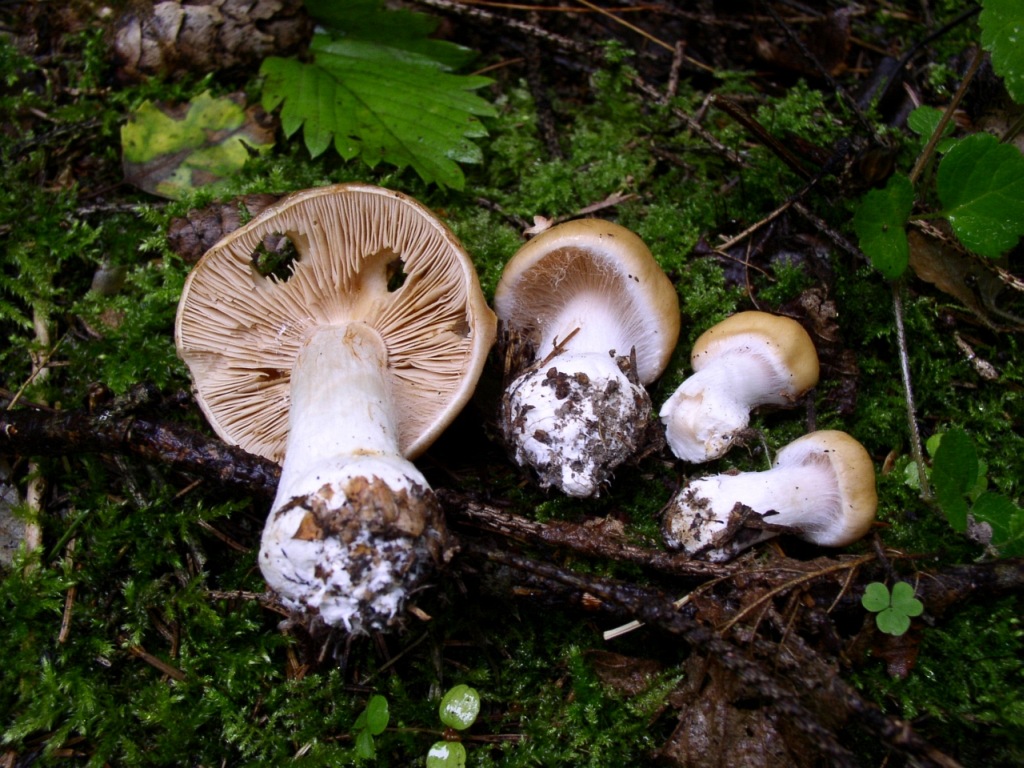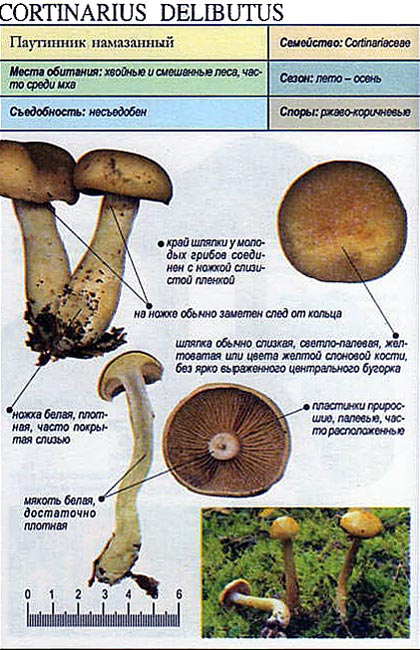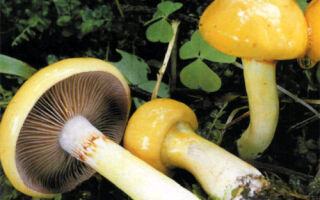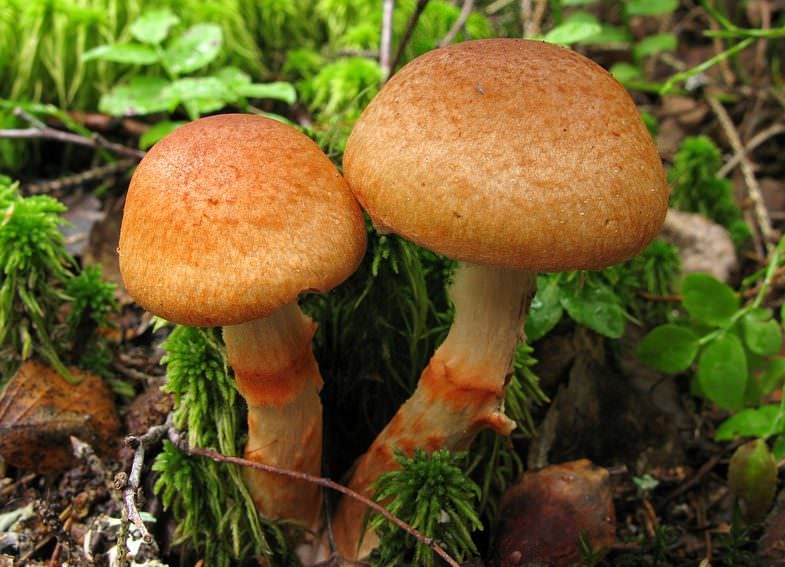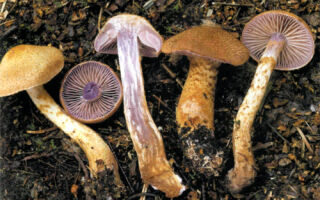Description of the edible webcap
The diameter of the cap is 5-8 centimeters. The cap is dense, fleshy, its edges are wrapped inward, over time it becomes flat-convex and can even acquire a depressed shape. The surface of the cap is watery, smooth. The color is grayish white.

The plates are often located, wide, adherent to the stem. The color of the plates is clayey. The pulp is thick, dense, white, has a pleasant mushroom smell. Spore powder of yellow-brown color. The size of the spores is 9-12 × 6-8 microns, their shape is ellipsoidal, the surface is warty, the color is yellow-brown.
The leg of the edible spider web is dense and even. The coloration of the leg is whitish-brown. In its central part there are remnants of a cobweb picture, which eventually disappear. The length of the leg is small - 2-3 centimeters, and the diameter is 1.5-2 centimeters.
Growth area and fruiting time of edible spiderwebs
These mushrooms are common in the European part of our country, and they are also found in the forests of Belarus. You can find them in coniferous forests. These mushrooms bear fruit from September to October.
Evaluation of the taste characteristics of edible cobwebs
The cobweb is edible, suitable for eating. These mushrooms taste sweetish, in addition, they have a pleasant mushroom smell.

Other mushrooms of this genus
The excellent webcap has a cap diameter of 10-20 centimeters. At a young age, the shape of the caps is hemispherical, but as the fruit bodies mature, it becomes flat and even depressed. The surface of the cap is velvety. In adult mushrooms, the color is almost purple, wine and red-brown. Length legs are 10-14 centimeters, with a thickness of 2-5 centimeters. The stem color can be pale purple, light ocher or whitish.
Superb webcaps are rare, in many European countries they are included in the Red Book. This species does not grow on the territory of our country. Excellent cobwebs settle in numerous groups. They grow in deciduous and mixed forests. Fruiting from August to September. They can often be found next to birches. Although the cobweb is an excellent, little-studied mushroom, it is edible and suitable for drying and pickling.
The crimson webcap has a cap with a diameter of up to 15 centimeters, and the height of its legs is 6-8 centimeters. The shape of the cap changes from convex to flat as the fruiting body grows. The hat is sticky to the touch. The color of the cap varies from brown-olive to red-brown.

Information on the edibility of crimson cobwebs is contradictory, since their nutritional properties are poorly studied.
The abnormal webcap is characterized by a convex shape of the cap, but over time it changes to a flat one. The color of the cap is initially gray or gray-brown, and the edges are bluish-purple, but gradually the color of the cap changes to red-brown. The length of the leg is 7-10 centimeters, with a diameter of 0.5-1 centimeters. The color of the leg is whitish with a lilac or brown tint. On the surface of the leg, light fibrous remains of the bedspread are noticeable.
Anomalous spider webs grow in small colonies, and they can also be found singly. They choose coniferous and deciduous forests, grow in the ground, or on a litter of leaves or needles. Fruiting from August to September. Anomalous spider webs are widespread in Germany, Austria, Sweden, France, Switzerland, Estonia and Belarus.
They also grow in the USA and Morocco. In our country, they are found in the Irkutsk, Amur, Tver, Chelyabinsk and Yaroslavl regions, and in the Khabarovsk and Krasnoyarsk regions. The nutritional properties of anomalous spiderwebs have not been studied enough, but scientists classify these mushrooms as inedible.

White-purple spider web, Cortinarius alboviolaceus
Hat: Medium size (diameter 5-8 cm), fleshy, bell-shaped or hemispherical in youth, as the mushroom matures, it acquires a characteristic half-extended shape with a blunt tubercle in the center. Color - light gray or silvery with a purple tint; the surface is not slimy, smooth, silky, covered with rather rare radial fibers of a more violet color in comparison with the base. The pulp is thick, grayish, friable, with an unpleasant musty smell characteristic of many cobwebs.
Hymenophore: The plates are poorly adherent, of medium frequency, narrow, with frequent veins; in adult mushrooms, they are rusty-brown; in young ones, while covered with a light gray cortina, they are gray-gray, bluish, but already with rusty edges.
Spore powder: Rusty brown.
Leg: Long and powerful (height 6-10 cm, thickness 1.5-2 cm), cylindrical, evenly expanding to the bottom, cap color, often with blue stains. The remnants of the silvery cortina are usually not visible, but when ripening spores fall on it, it becomes rusty-brown in color and becomes very noticeable. The flesh of the leg is gray-bluish, unevenly colored, often watery and friable.
Spreading: The white-purple webcap is found in September-October in deciduous and mixed forests, forming a mycorrhiza with a variety of trees. Prefers moist places, mosses, where it can appear in large quantities.
Similar species: There are many similar mushrooms among the endless genus of spider webs. From more violet varieties such as Cortinarius traganus, the white and purple cobweb is easily distinguished by the color of the cap, which is never so blue; Unlike C. salor, our figurant's leg and cap are not particularly slimy, except maybe rain. How to distinguish Cortinarus alboviolaceus from the silvery spider web, Cortinarius argentatus, does not exist in the popular literature; obviously, one should rely on the presence or absence of blue tones in the color. In general, the distinction of cobwebs, even such noticeable as white and purple, is extremely unpromising.
Edibility: According to literature data, it is not poisonous; according to the same data, it does not bring gastronomic joy to anyone.
Author's notes: The reportable Cortinarius alboviolaceus is another cobweb that can be identified right in the forest with at least some nonzero probability. That's why we love him. If it is, of course, he.
The tubercle is not visible, but it is. The white-purple cobweb is somewhat smaller than most similar blue or purple cobwebs, but in texture this mushroom is not much different from them - the same powerful and lumpy-headed. Under the silvery layer on the cap and stem, the latent blue is clearly visible, which gives a good reason to record this specimen in Cortinarius alboviolaceus.
The plates are brown, and the stripes on the leg are rusty. The rusty stripes on the leg of this white and purple spider web are the remains of a cortina, strewn with spores of the corresponding color. Why are cobwebs good - you don't even need to make an eruption of spore powder, everything is in full view. However, this feature does not help in the definition. Such are the mushrooms - cobwebs. Woven, excuse the expression, of riddles and contradictions.
Common webcap (Cortinarius trivialis) what it looks like, where and how it grows, edible or not
Common webcap: photo and description
| Name: | Common webcap |
| Latin name: | Cortinarius trivialis |
| Type of: | Inedible |
| Specifications: |
|
| Systematics: |
|
The common webcap (lat.Cortinarius trivialis) is a small mushroom of the Cobweb family. The second name - Pribolotnik - he received for preference to growing conditions. It is found in wet, swampy areas.
A detailed description of the Common Webcap with photos and videos is presented below.
Description of the common webcap
The mushroom was called a cobweb for a kind of "veil" of a cobweb film that is present in young specimens.The rest of the appearance is unremarkable.
Description of the hat
Pribolotnik's cap is small: 3-8 cm in diameter. At the initial stage of development, it has the shape of a hemisphere, which is later revealed. The color of the cap ranges from pale yellow tones to ocher and light brown shades. The core is darker than the edges.
The cap is sticky to the touch, there is a small amount of mucus on it. The surface of the hymenophore is lamellar. In young fruit bodies, it is white, and in mature specimens it darkens to yellowish and brown tones.
The pulp is dense and fleshy, white, with a harsh odor.
Leg description
The leg is 6-10 cm in height, the diameter is 1.5-2 cm. Slightly narrowed towards the base. There are specimens with a reverse structure - there is a small expansion at the bottom. The color of the leg is white, closer to the ground it darkens to a brown tint. Above from the cobweb blanket are brown concentric fibrous bands. From the middle of the leg to the base - weakly expressed.
Where and how it grows
Podbolnik can be found under birches and aspens, rarely under alder. It rarely lives in coniferous forests. Grows singly or in small groups in damp places.
In Russia, the distribution area of the species falls on the middle climatic zone.
Fruiting from July to September.
Edible webcap common or not
The nutritional properties of the Common Webcap have not been studied, but it does not apply to edible mushrooms. This species cannot be eaten.
Related specimens contain dangerous toxins in the pulp.
Poisoning symptoms, first aid
The danger of toxic species of this family is that the first signs of poisoning appear gradually: up to 1-2 weeks after eating mushrooms. Symptoms look like this:
- intense thirst;
- nausea, vomiting;
- stomach ache;
- spasms in the lumbar region.
If you find the first signs of poisoning, you must urgently consult a doctor or call an ambulance. Before receiving qualified treatment, you need to:
- flush the stomach using activated charcoal;
- plentiful drink (3-5 tbsp. boiled water in small sips);
- take a laxative to cleanse the intestines.
Doubles and their differences
The podbolnik is confused with other members of the family, as they are quite similar. The greatest similarity is noted with the mucous webcap (lat.Cortinarius mucosus).
The hat is 5-10 cm in diameter. It has a thin edge and a thick center, abundantly covered with transparent mucus. The leg is slender, cylindrical, 6-12 cm long, 1-2 cm thick.
It differs from Pribolotnik in abundant mucus and the shape of a cap.
Grows in coniferous and mixed forests under pine trees. Bears fruit singly.
The slime webcap (lat.Cortinarius mucifluus) is another twin of the Pribolotnik, which is confused with the mucous webcap because of a similar name. The hat with a diameter of 10-12 cm is abundantly covered with mucus. The stem is 20 cm long in the form of a spindle, also covered with mucus. Prefers coniferous forests.
It differs from Pribolotnik in abundant mucus and a longer leg.
Conclusion
The common webcap is an inedible mushroom, its properties have not been fully studied. Can be confused with other members of the family, the use of which is not recommended. The greatest similarity is noted with the Slime Webcap and the Slime Webcap, but they can be distinguished by their cap. In the latter, it is abundantly covered with mucus.
Additional information about the common webcap:
External description
The abnormal webcap (Cortinarius anomalus) has a fruiting body, consisting of a leg and a cap. Initially, its cap is characterized by a bulge, but in mature mushrooms it becomes flat, dry to the touch, silky and smooth. The color of the mushroom cap is initially grayish-brown or gray, and its edge is characterized by a bluish-purple color. Gradually, the cap turns reddish brown or brown.
A mushroom leg is characterized by a length of 7-10 cm and a girth of 0.5-1 cm.In shape, it is cylindrical, has a thickening at the base, in young mushrooms it is full, and in mature it becomes empty from the inside. It is whitish in color, with a brown or lilac tint. On the surface of the mushroom leg, you can see the fibrous, light-colored remnants of a private bedspread.
The mushroom pulp is well developed, has a whitish color, and has a slightly purple tint on the stem. It has no smell, but the taste is mild. The hymenophore is represented by plates adherent to the inner surface of the cap, characterized by a large width and frequent location. Initially, the plates are grayish-purple in color, but as the fruit bodies mature, they become rusty-brown. They contain spores of a wide-oval fungus, measuring 8-10 * 6-7 microns. At the end, the spores are pointed, have a light yellow color, and are covered with small warts.
Spider web brilliant: photo and description
| Name: | The webcap is brilliant |
| Latin name: | Cortinarius evernius |
| Type of: | Inedible |
| Specifications: |
|
| Systematics: |
|
The brilliant webcap (Cortinarius evernius) belongs to the Cobweb family and is extremely rare in Russia. During wet weather, its cap becomes shiny and becomes covered with transparent mucus, acquiring a glossy sheen, which is why it got its name.
What a brilliant spider web looks like
In accordance with its generic name, the mushroom has the remains of a velum with a spider-like structure. The flesh is tasteless, reddish in color with a slight unpleasant odor.
The spore body of the spider web is of a brilliant brown hue, consists of rare plates adhered to the leg. The spore powder has a rusty brown color. The spores themselves are medium-sized, smooth-walled, oval in shape.
In a young mushroom, the shape is at first sharp-bellied, dark brown in color with a lilac tint
Description of the hat
The cap of the mushroom is round in shape, its diameter is about 3-4 cm. With age, it opens, the fields increase, a small tubercle remains in the center. The color ranges from dark brown with a lilac tint to rusty orange.
The plates on the inner side, adhered with a tooth, are wide, have a medium frequency. The color is grayish-brown, later they acquire a chestnut color with a purple tint. The cobweb blanket remains white throughout the growth.
The flesh of the cap is also thin, but dense, has a brown color with a lilac tint
Leg description
The stem of the mushroom is in the shape of a cylinder, tapering towards the base. It is 5-10 cm long and about 0.5-1 cm in diameter. The color varies from gray to purple-coffee. White rings are noticeable along the entire length, which disappear with increased humidity.
Inside the leg is hollow, smooth and fibrous-silky
Where and how it grows
The most common cobweb is brilliant in the north of the European part of Russia and in the middle zone, it is also found in the Caucasus. The season starts at the end of summer - from the second half of August. Grows in mixed and coniferous forests.
Most often found in mossy places with high humidity: ravines, lowlands or near swamps. Glittering cobwebs grow in small groups of 2-4 mushrooms at the foot of pines and firs. Also found singly under bushes and among fallen leaves
Is the mushroom edible or not
The brilliant webcap belongs to inedible mushrooms. It does not contain any toxic substances and is not hazardous to health, but the unpleasant smell and taste of the pulp make it unsuitable for human consumption.
Doubles and their differences
The brilliant webcap can be easily confused with several more representatives of this species.
Slime cobweb (Cortinarius mucifluus) - is a conditionally edible species. The diameter of the cap is from 10 to 12 cm.The form is bell-shaped at first, then straightens and becomes flat with uneven jagged edges. The leg is fusiform, 15-20 cm long, with a white color. The pulp is creamy, tasteless and odorless.
It differs from the brilliant cobweb in the absence of an unpleasant odor and mucus on the cap, even in dry weather
The most beautiful or reddish webcap (Cortinarius rubellus) is a poisonous mushroom that belongs to inedible. The length of the leg is 5-12 cm and from 0.5 to 1.5 cm in thickness, it expands downward. It has a brown-orange fibrous surface with light rings along its entire length. The diameter of the cap varies from 4 to 8 cm. The initial shape is conical. Further, it levels out, leaving a small convex mound at the top. The surface is smooth and dry with irregular edges of a brownish-red or brownish-purple color. The pulp is yellow-orange in color, odorless and tasteless.
It differs from the spiderweb of a brilliant rusty-reddish color and a lighter shade of the cap
Conclusion
The brilliant webcap is strictly not recommended to be cut and eaten. Having found it in the forest, you should be extremely careful: other edible spiderwebs can be confused with it. Most often it can be found in forests with a predominance of pines and birches.
Myxacium (Fr.) Loud. - Mixcium
Oiled webcap
Spider web yellowish white
Webcap blue
Dripping cobweb
Trembling cobweb
Fruit bodies are medium fleshy.
The cap is hygrophilous or non-hygrophilous, slimy, sometimes sticky. The hyphae of the skin are 7–20 µm in diameter.
The leg is slimy, sticky.
The covers are mucous.
Spores are ellipsoidal, almost spherical, almond-shaped or lemon-shaped, rough or coarsely warty.
- Cortinarius aerugineoconicus E. Horak, 1990
- Cortinarius archeri Berk., 1860
- Cortinarius arvinaceus Fr., 1838 - Fat webcap
- Cortinarius austroalbidus Cleland & J.R. Harris, 1948
- Cortinarius basipurpureus (Bougher) Peintner & Mos., 2002
- Cortinarius bellus E. Horak, 1990
- Cortinarius betulinus Favre, 1948 - Birch webcap
- Cortinarius bundarus Grgur., 1989
- Cortinarius causticus Fr., 1838 - Acid webcap, or pungent
- Cortinarius collinitus (Sow.: Fr.) Fr., 1838 typus - Staining webcap
- Cortinarius costaricensis Ammirati, Halling & Garnica, 2007
- Cortinarius croceo-coeruleus (Pers.: Fr.) Fr., 1851 - Saffron-blue webcap
- Cortinarius crystallinus Fr., 1838 - Crystal webcap, or crystal clear
- Cortinarius cucumeris E. Horak, 1990
- Cortinarius cycneus E. Horak, 1990
- Cortinarius delibutus Fr., 1838 - Cobweb smeared, or oiled
- Cortinarius eburneus (Velen.) Henry ex Bon, 1985 - Yellowish-white webcap
- Cortinarius emollitus Fr., 1838 - Soft or softened webcap
- Cortinarius emunctus Fr., 1838 - Steel-blue webcap
- Cortinarius epipoleus Fr., 1838 - Epipolean webcap
- Cortinarius erythraeus Berk., 1845
- Cortinarius favrei Mos. ex Henderson, 1958 - Favre's Webcap
- Cortinarius ignotus E. Horak 1990
- Cortinarius illibatus Fr., 1838 - Whole webcap
- Cortinarius indolicus E. Horak, 1990
- Cortinarius iodes Berk. & M.A. Curtis 1853
- Cortinarius lividoochraceus (Berk.) Berk., 1836 - Lead-buffy webcap, or high
- Cortinarius magellanicus Speg., 1887
- Cortinarius marmoratus E. Horak, 1990
- Cortinarius metrodii Henry, 1985 - Metrod's Webcap
- Cortinarius microarcheri Cleland, 1933
- Cortinarius mucifluus Fr., 1838 - Slimy webcap
- Cortinarius mucosus (Bull.: Fr.) J. Kickx f., 1867 - Slimy webcap
- Cortinarius ochroleucus (Schaeff.: Fr.) Fr., 1838 - Cobweb ocher-white, or reddish-whitish
- Cortinarius olorinatus E. Horak, 1990
- Cortinarius pluviorus (J. Schaeff.: Mos.) Mos., 1967 - Rain webcap
- Cortinarius pluvius (Fr.) Fr., 1838 - Rainy webcap
- Cortinarius porphyrophaeus E. Horak, 1990
- Cortinarius pumilus (Fr.) J. Lange 1940 - Dwarf webcap
- Cortinarius salor Fr., 1838 - Blue webcap, or lilac
- Cortinarius sinapicolor Cleland, 1933
- Cortinarius stillatitius Fr., 1838 - Dripping webcap, or blue-footed
- Cortinarius subarcheri Cleland, 1928
- Cortinarius subarvinaceus Cleland, 1927
- Cortinarius taylorianus E. Horak, 1990
- Cortinarius trivialis J. Lange, 1935 - Common webcap
- Cortinarius vanduzerensis A.H. Sm. & Trappe, 1972
- Cortinarius vibratilis (Fr.) Fr., 1838 - Trembling webcap, or bitter, or iridescent
- Cortinarius viscoviridis E. Horak, 1990
Crimson webcap (Cortinarius purpurascens)
Scarlet webcap (Cortinarius purpurascens) - a mushroom, which according to some sources belongs to the edible, belongs to the Spiderweb genus, the Cobweb family. The main synonym for its name is the French term Cortinarius purpurascens.
External description
The fruit body of the crimson spider web consists of a leg 6 to 8 cm long and a cap, the diameter of which is up to 15 cm. Initially, the cap has a convex shape, but in ripening mushrooms it becomes prostrate, sticky to the touch and flat. The flesh of the cap is characterized by its fiber, and the color of the cap itself can vary from olive brown to reddish brown, with a slightly darker color in the central part. When the pulp dries, the cap ceases to shine.
The mushroom pulp is characterized by a bluish tint, but upon mechanical action and cutting it acquires a purple color. The pulp of this mushroom, as such, has no taste, but the aroma is pleasant.
The girth of the mushroom stalk varies within 1-1.2 cm, the stalk is very dense in structure, at the base it acquires a tuberous swollen shape. The main color of the stem of the mushroom is purple.
The hymenophore is located on the inner surface of the cap, and consists of plates adhered to the pedicle with a tooth, initially having a purple color, but gradually becoming rusty-brown or brownish. The plates contain a spore powder of rusty-brown color, consisting of almond-shaped spores covered with warts.
Season and habitat
Active fruiting of the crimson spider web occurs in the autumn period. The fungus of this species can be found in mixed, deciduous or coniferous forests, mainly at the end of August and throughout September.
Edibility
Information about whether the crimson cobweb is edible is controversial. Some sources say that this type of mushroom is allowed to be eaten, while others indicate that the fruiting bodies of this mushroom are not suitable for eating, since they have low taste. Conventionally, the crimson spider web can be called edible, mainly it is eaten salted or pickled. The nutritional properties of the species have been little studied.
Similar types and differences from them
The scarlet spider web is similar in appearance to some other types of spider web. The main distinguishing features of the species is the fact that the flesh of the described mushroom, under mechanical action (pressure), changes its color to bright purple.
Season and habitat
Anomalous webcap (Cortinarius anomalus) grows in small groups or singly, mainly in deciduous and coniferous forests, on a litter of leaves and needles, or in the ground. The fruiting period of the species falls on the end of August and September. In Europe, it grows in Austria, Germany, Bulgaria, Norway, Great Britain, Belgium, Lithuania, Estonia, Belarus, Sheitzaria, France and Sweden. You can also see anomalous cobwebs in the United States, the Greenland Islands and Morocco. This species also grows in some regions of Russia, in particular, in Karelia, Yaroslavl, Tver, Amur Irkutsk, Chelyabinsk regions. There is this mushroom in the Primorsky Territory, as well as in the Krasnoyarsk and Khabarovsk Territories.

